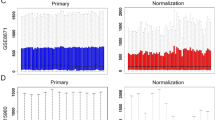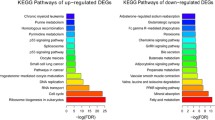Abstract
Colorectal cancer (CRC) is among the most lethal human cancers, but the mechanism of the cancer is still unclear enough. We aimed to explore the key genes in CRC progression. The gene expression profile (GSE4183) of CRC was obtained from Gene Expression Omnibus database which included 8 normal samples, 15 adenoma samples, 15 CRC samples and 15 inflammatory bowel disease (IBD) samples. Thereinto, 8 normal, 15 adenoma, and 15 CRC samples were chosen for our research. The differentially expressed genes (DEGs) in normal vs. adenoma, normal vs. CRC, and adenoma vs. CRC, were identified using the Wilcoxon test method in R respectively. The interactive network of DEGs was constructed to select the significant modules using the Pearson’s correlation. Meanwhile, transcriptional network of DEGs was also constructed using the g: Profiler. Totally, 2,741 DEGs in normal vs. adenoma, 1,484 DEGs in normal vs. CRC, and 396 DEGs in adenoma vs. CRC were identified. Moreover, function analysis of DEGs in each group showed FcR-mediated phagocytosis pathway in module 1, cardiac muscle contraction pathway in module 6, and Jak-STAT signaling pathway in module 19 were also enriched. Furthermore, MZF1 and AP2 were the transcription factor in module 6, with the target SP1, while SP1 was also a transcription in module 20. DEGs like NCF1, AKT, SP1, AP2, MZF1, and TPM might be used as specific biomarkers in CRC development. Therapy targeting on the functions of these key genes might provide novel perspective for CRC treatment.




Similar content being viewed by others
References
Rebecca SM, Deepa Naishadham MA, Ahmedin Jemal DVM (2013) Cancer statistics, 2013. CA Cancer J Clin 63:11–30
Chen W-Q, Zeng H-M, Zheng R-S et al (2012) Cancer incidence and mortality in China, 2007. Chin J Cancer Res 24:1–8
Goel A, Boland CR (2012) Epigenetics of colorectal cancer. Gastroenterology 143:1442–1460
Garagnani P, Pirazzini C, Franceschi C (2013) Colorectal cancer microenvironment: among nutrition, gut microbiota, inflammation and epigenetics. Curr Pharm Des 19:765–778
Vinci S, Gelmini S, Mancini I et al (2013) Genetic and epigenetic factors in regulation of microRNA in colorectal cancers. Methods 59:138–146
Wilkinson J (2012) Epigenome enhancer profiling reveals signature for colon cancer. Epigenomics 4(3):248
Schweiger MR, Hussong M, Rohr C et al (2013) Genomics and epigenomics of colorectal cancer. Wiley Interdiscip Rev Syst Biol Med 5:205–219
Han Y, Kuang Y, Xue X et al (2014) NLK, a novel target of miR-199a-3p, functions as a tumor suppressor in colorectal cancer. Biomed Pharmacother 9:003
Zhang Y, Tian X, Ji H et al. (2014) Expression of SATB1 Promotes the Growth and Metastasis of Colorectal Cancer. PloS one 9
Van Cutsem E, Köhne C-H, Láng I et al (2011) Cetuximab plus irinotecan, fluorouracil, and leucovorin as first-line treatment for metastatic colorectal cancer: updated analysis of overall survival according to tumor KRAS and BRAF mutation status. JCO 2010(2033):5091
Misale S, Yaeger R, Hobor S et al. (2012) Emergence of KRAS mutations and acquired resistance to anti-EGFR therapy in colorectal cancer. Nature
Galamb O, Sipos F, Solymosi N et al (2008) Diagnostic mRNA expression patterns of inflamed, benign, and malignant colorectal biopsy specimen and their correlation with peripheral blood results. Cancer Epidemiol Biomarkers Prev 17:2835–2845
Nam S, Park T (2012) Pathway-based evaluation in early onset colorectal cancer suggests focal adhesion and immunosuppression along with Epithelial-Mesenchymal transition. PLoS ONE 7:e31685
Heijink D, Fehrmann R, de Vries E et al (2011) A bioinformatical and functional approach to identify novel strategies for chemoprevention of colorectal cancer. Oncogene 30:2026–2036
Barrett T, Troup DB, Wilhite SE et al (2007) NCBI GEO: mining tens of millions of expression profiles—database and tools update. Nucleic Acids Res 35:D760–D765
Irizarry RA, Hobbs B, Collin F et al (2003) Exploration, normalization, and summaries of high density oligonucleotide array probe level data. Biostatistics 4:249–264
Gehan EA (1965) A generalized Wilcoxon test for comparing arbitrarily singly-censored samples. Biometrika 52:203–223
Adler J, Parmryd I (2010) Quantifying colocalization by correlation: the pearson correlation coefficient is superior to the Mander’s overlap coefficient. J Int Soc Anal Cytol 77:733–742. doi:10.1002/cyto.a.20896
Collobert R, Bengio S, Mariéthoz J (2002) Torch: a modular machine learning software library. Technical Report IDIAP-RR 02-46, IDIAP
Reimand J, Kull M, Peterson H et al (2007) g: Profiler—a web-based toolset for functional profiling of gene lists from large-scale experiments. Nucleic Acids Res 35:W193–W200
Alvord G, Roayaei J, Stephens R et al (2007) The DAVID gene functional classification tool: a novel biological module-centric algorithm to functionally analyze large gene lists. Genome Biol 8:R183
Ashburner M, Ball CA, Blake JA et al (2000) Gene ontology: tool for the unification of biology. Nat Genet 25:25
Ogata H, Goto S, Sato K et al (1999) KEGG: kyoto encyclopedia of genes and genomes. Nucleic Acids Res 27:29–34
Matys V, Fricke E, Geffers R et al (2003) TRANSFAC: transcriptional regulation, from patterns to profiles. Nucleic Acids Res 31:374–378
van Spriel AB, van Ojik HH, Bakker A et al (2003) Mac-1 (CD11b/CD18) is crucial for effective Fc receptor–mediated immunity to melanoma. Blood 101:253–258
Roos D, de Boer M, Koker MY et al (2006) Chronic granulomatous disease caused by mutations other than the common GT deletion in NCF1, the gene encoding the p47phox component of the phagocyte NADPH oxidase. Hum Mutat 27:1218–1229
Suraweera N, Zampeli E, Rogers P et al (2004) NCF1 (p47phox) and ncf1 pseudogenes are not associated with inflammatory bowel disease. Inflamm Bowel Dis 10:758–762
Parry D, Squire J (1973) Structural role of tropomyosin in muscle regulation: analysis of the x-ray diffraction patterns from relaxed and contracting muscles. J Mol Biol 75:33–55
Luo YX, Cui J, Wang L et al (2009) Identification of cancer-associated proteins by proteomics and downregulation of beta-tropomyosin expression in colorectal adenoma and cancer. Proteomics Clin Appl 3:1397–1406
Mlakar V, Berginc G, Volavsek M et al (2009) Presence of activating KRAS mutations correlates significantly with expression of tumour suppressor genes DCN and TPM1 in colorectal cancer. BMC Cancer 9:1471–2407
Franke TF, Yang S-I, Chan TO et al (1995) The protein kinase encoded by the < i > Akt</i > proto-oncogene is a target of the PDGF-activated phosphatidylinositol 3-kinase. Cell 81:727–736
Baba Y, Nosho K, Shima K et al (2011) Phosphorylated AKT expression is associated with PIK3CA mutation, low stage, and favorable outcome in 717 colorectal cancers. Cancer 117:1399–1408
Agarwal E, Brattain MG, Chowdhury S (2013) Cell survival and metastasis regulation by Akt signaling in colorectal cancer. Cell Signal 25:1711–1719
PIM JS JAK-STAT signaling pathway.
Diaz T, Navarro A, Ferrer G et al (2011) Lestaurtinib inhibition of the Jak/STAT signaling pathway in hodgkin lymphoma inhibits proliferation and induces apoptosis. PLoS ONE 6:0018856
Yue CH, Chiu YW, Tung JN et al (2012) Expression of protein kinase C alpha and the MZF-1 and Elk-1 transcription factors in human breast cancer cells. Chin J Physiol 55:31–36
Hsieh YH, Wu TT, Huang CY et al (2007) Suppression of tumorigenicity of human hepatocellular carcinoma cells by antisense oligonucleotide MZF-1. Chin J Physiol 50:9–15
Mudduluru G, Vajkoczy P, Allgayer H (2010) Myeloid zinc finger 1 induces migration, invasion, and in vivo metastasis through Axl gene expression in solid cancer. Mol Cancer Res 8:159–169
Deng Y, Wang J, Wang G et al (2013) p55PIK transcriptionally activated by MZF1 promotes colorectal cancer cell proliferation. Biomed Res Int 868131:23
Raman D, Sai J, Hawkins O et al (2014) Adaptor protein2 (AP2) orchestrates CXCR2-mediated cell migration. Traffic 15:451–469
Kadonaga JT, Carner KR, Masiarz FR et al (1987) Isolation of cDNA encoding transcription factor Sp1 and functional analysis of the DNA binding domain. Cell 51:1079–1090
Lam AK, Chan SS (2014) Leung M Synchronous colorectal cancer: clinical, pathological and molecular implications. World J Gastroenterol 20(22):6815–6820
Stabach PR, Thiyagarajan MM, Woodfield GW et al (2006) AP2alpha alters the transcriptional activity and stability of p53. Oncogene 25:2148–2159
Banerjee S, Sangwan V, McGinn O et al (2013) Triptolide-induced cell death in pancreatic cancer is mediated by O-GlcNAc modification of transcription factor Sp1. J Biol Chem 288:33927–33938
Li H, Zhang Y, Strose A et al (2014) Integrated high-throughput analysis identifies Sp1 as a crucial determinant of p53-mediated apoptosis. Cell Death Differ 27:69
Zhao Y, Zhang W, Guo Z et al (2013) Inhibition of the transcription factor Sp1 suppresses colon cancer stem cell growth and induces apoptosis in vitro and in nude mouse xenografts. Oncol Rep 30:1782–1792
Acknowledgments
This study was supported by Shanghai medical key subject construction project (NO.ZK2012A28), Key National Clinical Discipline construction project (2013)
Conflict of Interest
The Authors declare that they have no conflicts of interest to disclose.
Author information
Authors and Affiliations
Corresponding author
Additional information
Guoting Chen and Hengping Li contributed equally to this work.
Highlights:
1. NCF1 might be a biomarker for colon adenoma.
2. AKT and TPM contribute to the CRC development.
3. MZF1 might act as a promoter in CRC progression.
4. SP1, regulated by AP2, might prevent the CRC progression.
5. Three significant pathways related to CRC were enriched.
Rights and permissions
About this article
Cite this article
Chen, G., Li, H., Niu, X. et al. Identification of Key Genes Associated with Colorectal Cancer Based on the Transcriptional Network. Pathol. Oncol. Res. 21, 719–725 (2015). https://doi.org/10.1007/s12253-014-9880-9
Received:
Accepted:
Published:
Issue Date:
DOI: https://doi.org/10.1007/s12253-014-9880-9




